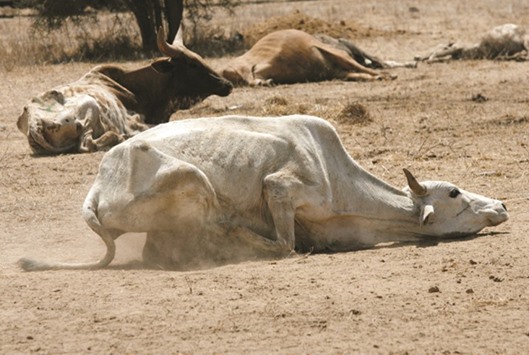A worsening drought hitting Somalia, Ethiopia and Kenya has left more than 11mn people facing severe hunger, the International Federation of Red Cross and Red Crescent Societies (IFRC) said yesterday.
“This is the worst situation we have seen in the region since 2011, when more than a quarter of a million people died in Somalia alone,” said Fatoumata Nafo-Traore, IFRC regional director for Africa.
The situation is the worst in Somalia, where nearly 40% of the population need some form of humanitarian assistance and deaths have already been reported in the north, according to the IFRC.
The charity Save the Children said tens of thousands of Somalis were leaving their homes in search for food, water and grazing lands for their animals, while camels were dying.
“Conditions are the driest they’ve been in decades and the landscape is peppered with goat carcasses,” Hassan Noor Saadi, Save the Children’s country director in Somalia, said in a statement.
“In some places, we’re now seeing dead camels – normally a grim precursor to a loss in human life,” Noor Saadi said.
In light of the conditions, the United Nations issued a pre-famine alert for Somalia earlier this month, saying that more than 6mn people face acute food insecurity.
Some 71,000 children are already severely malnourished and “at risk of death”, with more than 360,000 children under the age of five acutely malnourished, according to Save the Children.
Reports of rain falling just before Christmas saw hundreds of trucks carrying families and livestock travel to coastal areas of Puntland, in the nation’s northeast.
The area is actually facing its worst drought since 1950, the charity said.
The movement of those seeking water, food and aid shows that “rural families are on the brink”, Noor Saadi said.
Somalia has seen consecutive seasons of low rainfall, according to the UN, meaning drought has already wiped out crops and killed livestock in the most affected areas.
Kenya has meanwhile experienced large-scale loss of livestock, while in Ethiopia the impact of the drought is compounded by an influx of people fleeing the drought in Somalia, the IFRC said.
The IFRC appealed for a total of about $13mn for the three countries, only about 22% of which has been secured so far.
Kenya declared a national disaster yesterday, calling for aid to counter drought that is posing a major risk to people, livestock and wildlife.
The Kenya Red Cross has estimated around 2.7mn people are in need of food aid after low rainfall in October and November and the next rainy season not due before April.
President Uhuru Kenyatta called for “local and international partners to come in and support the government’s efforts to contain the situation”, a statement from his office said.
The UN World Food Programme said it was short of $22mn for the next six to nine months to provide support such as school meals for 428,000 children who often depend on them as their only substantial meal of the day.
The presidency did not set out how much the government needed for the drought, but said it had released 7.3bn shillings ($70mn) and local authorities had provided another 2bn shillings.
Out of Kenya’s 47 counties, 23 have been deemed to be facing disastrous drought.
“The government intends to enhance the interventions including doubling of food rations and cash transfers among other measures,” the presidency statement said.
Early this month, residents in drought-struck northern Kenya said at least 11 people were killed and a tourist lodge torched due to conflicts when armed cattle herders flooded onto farms and wildlife reserves.

This file picture shows a weak cow attempting to move in a paddock at the Kenya Meat Commission (KMC) factory, near Athi River, 50km east of the capital Nairobi.


